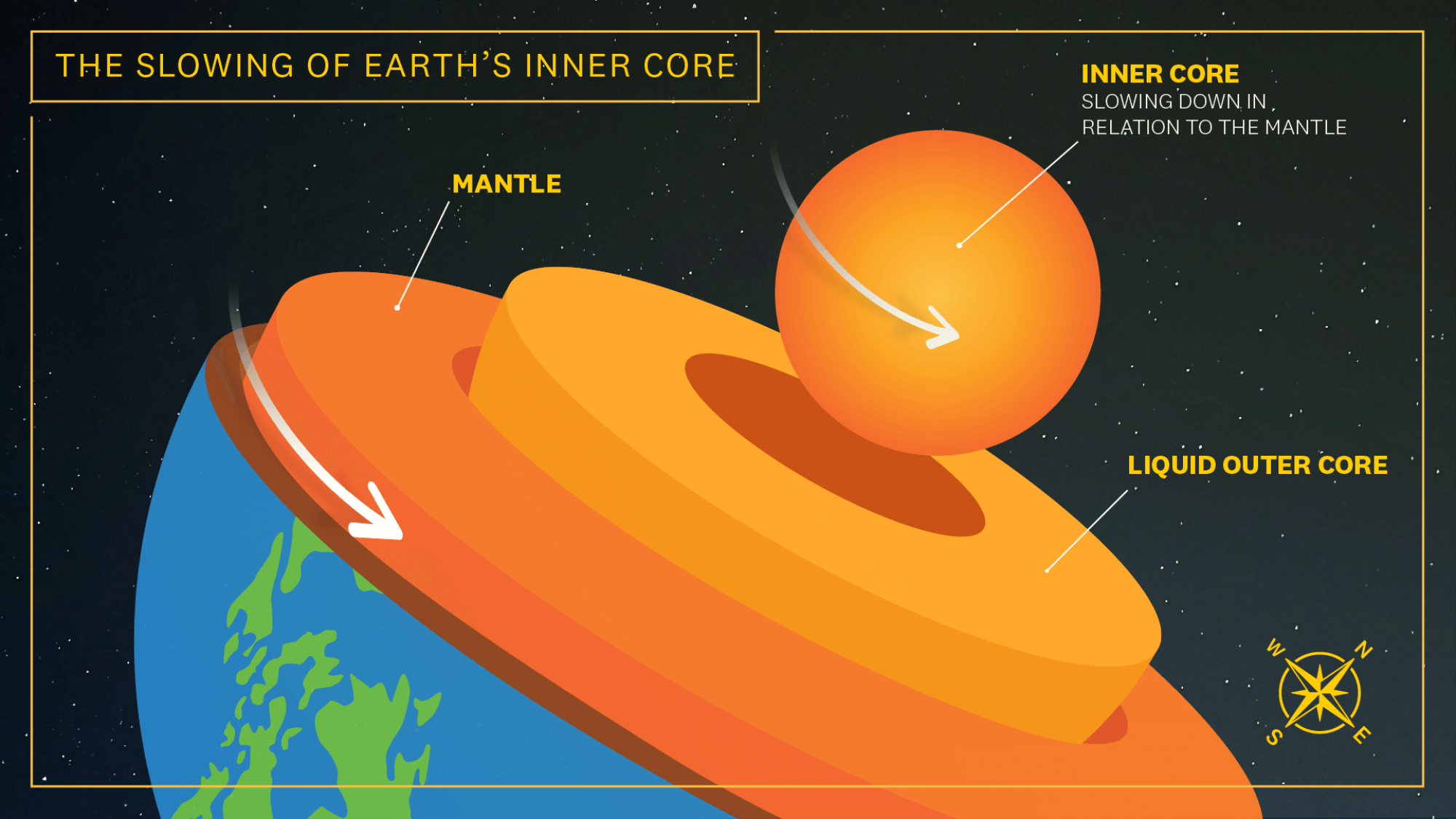Science
The spinning of Earth's inner core is slowing down. Is this how it all ends?

Geophysicist John Vidale noticed something striking while tracking the way seismic waves move from Earth’s crust through its core.
The very center of the planet, a solid ball of iron and nickel floating in a sea of molten rock, appears to be slowing down in relation to the movement of Earth itself. The inner core has slowed so much that it has essentially kicked into reverse.
The fluctuations happening 3,000 miles underground won’t affect life on the planet’s surface in any noticeable way — at least not for now, USC geophysicist John Vidale said.
(Christina House / Los Angeles Times)
The finding by Vidale and his counterpart Wei Wang of the Chinese Academy of Sciences, published recently in the journal Nature, offers the most convincing evidence yet that the core seems to operate with a mind of its own.
“It might be cycling back and forth but it might also be on a random walk,” Vidale said. “It went one way for a while, then it’s going back the other way. Who knows what it’s going to do next?”
The fluctuations happening 3,000 miles beneath us won’t affect life on the planet’s surface in any noticeable way — at least not for now, Vidale said.
“There’s essentially no effect on people, from what we’ve seen,” said Vidale, who is Dean’s Professor of Earth Sciences at the USC Dornsife College of Letters, Arts and Sciences. “It’s a part of basically understanding the evolution of the planet. What we’d also like to know in more detail is what are the forces that are moving the inner core.”
Scientists first had a hunch that the inner core was moving in the 1990s, he said. It has taken years to back up that theory with hard evidence, mainly because of the difficulty of studying a mass located so far out of reach — and suspended inside a hellish sea of liquid iron that’s between 8,000 and 10,000 degrees.
Instead, Vidale, who was director of the Southern California Earthquake Center at USC from 2017 to 2018, peered into the planet by tracking seismic waves from quakes occurring off the lower tip of South America. As the waves passed through the heart of the planet, they were recorded on 400 seismometers positioned at the other end of the globe in Alaska and Northern Canada. The sensors were the same kind used to measure ground vibrations during nuclear tests.

He compared those refined readings to quake signals recorded in past years to see where they matched. That’s how he determined that the rotation has been decreasing since 2010. Prior to that, the core’s spin had been accelerating.
The findings add to the mystique of the most inscrutable part of our world, Vidale said. Literature and lore involving Earth’s core have filled the knowledge void with all sorts of fanciful ideas.
“I’m not such a philosopher but we’ve all had nightmares of what’s going on down in the planet,” Vidale said. “Just a couple hundred years ago, people thought the planet was hollow and that there were people living down there. It’s pretty exotic — exotic like Jupiter, but it’s just right under our feet.”
In Jules Verne’s 1864 science-fiction classic “Journey to the Center of the Earth,” a German professor, his nephew and their guide descend into the planet through a volcano in Iceland — along the way encountering caverns, a subterranean ocean, living dinosaurs, strange sea creatures and even a prehistoric giant herding mastodons — and are finally spat out through a volcano off the coast of Sicily.
The 2003 disaster film “The Core” imagines that the rotation of Earth’s center has stalled, damaging the magnetic field that envelops the planet — and triggering a violent lightning storm that destroys Rome and “invisible microwaves” that melt the Golden Gate Bridge. A hotshot crew of scientists burrows down through Earth’s layers to jump-start the core with a nuclear bomb.
In the real world, no human could survive the unimaginable heat and bone-crushing pressure, even if there were a vehicle capable of tunneling to the core, Vidale said.
It is true that the outer core generates electrical currents that sustain the planet’s magnetic field, but Vidale says shifts in the Texas-size inner core are too minuscule to have an impact.
While the planet’s subterranean reality is less fantastical than novels and Hollywood movies make it out to be, it is still fascinating to those like Vidale whose job is to counter conjecture with facts.
What is increasingly clear is that the inner core is susceptible in different ways to activity in the layers of Earth that encircle it.
“The mechanics are that the outer core is circulating and making a magnetic field, and so it’s kind of pulling the inner core back and forth,” Vidale said.

The latest discoveries about the inner core have fueled vigorous disagreements among the world’s top Earth scientists, USC’s John Vidale says. Some don’t believe the core turns at all.
(Christina House/Los Angeles Times)
Another player in the endless tug-of-war taking place inside the planet is the lower level of the planet’s mantle, whose mix of hard and less-dense matter results in its own peculiar magnetic pull, Vidale said.
“We sort of think the outer core is stirring up the inner core, but the mantle’s trying to keep it aligned — maybe that’s why it’s oscillating,” he said.
The latest discoveries about the inner core have fueled vigorous disagreements among the world’s top Earth scientists and given rise to competing theories of varying credibility, Vidale says. Some don’t believe the core turns at all. Some insist that forces on the surface, such as quakes, briefly alter the rotation.
Over the phone, Vidale reads a review from a scientist in Australia who greeted Vidale’s recent findings with much skepticism. The Australian proclaims that the analysis will lead to “the erosion of seismology as a credible branch of science and the destruction of seismologists as credible researchers.”
“I think he’s just frustrated — he knows he’s lost,” Vidale said, gently ribbing his peer.
“It’s exciting because the core is pretty big, it’s moving by measurable amounts and it’s a mystery,” Vidale said. “We’re making progress and seeing more things, arguing with people around the world and trying to get more data … What our paper’s done is it’s convinced most of the community.”

Science
AI windfall helps California narrow projected $3-billion budget deficit

SACRAMENTO — California and its state-funded programs are heading into a period of volatile fiscal uncertainty, driven largely by events in Washington and on Wall Street.
Gov. Gavin Newsom’s budget chief warned Friday that surging revenues tied to the artificial intelligence boom are being offset by rising costs and federal funding cuts. The result: a projected $3-billion state deficit for the next fiscal year despite no major new spending initiatives.
The Newsom administration on Friday released its proposed $348.9-billion budget for the fiscal year that begins July 1, formally launching negotiations with the Legislature over spending priorities and policy goals.
“This budget reflects both confidence and caution,” Newsom said in a statement. “California’s economy is strong, revenues are outperforming expectations, and our fiscal position is stable because of years of prudent fiscal management — but we remain disciplined and focused on sustaining progress, not overextending it.”
Newsom’s proposed budget did not include funding to backfill the massive cuts to Medicaid and other public assistance programs by President Trump and the Republican-led Congress, changes expected to lead to millions of low-income Californians losing healthcare coverage and other benefits.
“If the state doesn’t step up, communities across California will crumble,” California State Assn. of Counties Chief Executive Graham Knaus said in a statement.
The governor is expected to revise the plan in May using updated revenue projections after the income tax filing deadline, with lawmakers required to approve a final budget by June 15.
Newsom did not attend the budget presentation Friday, which was out of the ordinary, instead opting to have California Director of Finance Joe Stephenshaw field questions about the governor’s spending plan.
“Without having significant increases of spending, there also are no significant reductions or cuts to programs in the budget,” Stephenshaw said, noting that the proposal is a work in progress.
California has an unusually volatile revenue system — one that relies heavily on personal income taxes from high-earning residents whose capital gains rise and fall sharply with the stock market.
Entering state budget negotiations, many expected to see significant belt tightening after the nonpartisan Legislative Analyst’s Office warned in November that California faces a nearly $18-billion budget shortfall. The governor’s office and Department of Finance do not always agree, or use the LAO’s estimates.
On Friday, the Newsom administration said it is projecting a much smaller deficit — about $3 billion — after assuming higher revenues over the next three fiscal years than were forecast last year. The gap between the governor’s estimate and the LAO’s projection largely reflects differing assumptions about risk: The LAO factored in the possibility of a major stock market downturn.
“We do not do that,” Stephenshaw said.
Among the key areas in the budget:
Science
California confirms first measles case for 2026 in San Mateo County as vaccination debates continue

Barely more than a week into the new year, the California Department of Public Health confirmed its first measles case of 2026.
The diagnosis came from San Mateo County, where an unvaccinated adult likely contracted the virus from recent international travel, according to Preston Merchant, a San Mateo County Health spokesperson.
Measles is one of the most infectious viruses in the world, and can remain in the air for two hours after an infected person leaves, according to the CDPH. Although the U.S. announced it had eliminated measles in 2000, meaning there had been no reported infections of the disease in 12 months, measles have since returned.
Last year, the U.S. reported about 2,000 cases, the highest reported count since 1992, according to CDC data.
“Right now, our best strategy to avoid spread is contact tracing, so reaching out to everybody that came in contact with this person,” Merchant said. “So far, they have no reported symptoms. We’re assuming that this is the first [California] measles case of the year.”
San Mateo County also reported an unvaccinated child’s death from influenza this week.
Across the country, measles outbreaks are spreading. Today, the South Carolina State Department of Public Health confirmed the state’s outbreak had reached 310 cases. The number has been steadily rising since an initial infection in July spread across the state and is now reported to be connected with infections in North Carolina and Washington.
Similarly to San Mateo’s case, the first reported infection in South Carolina came from an unvaccinated person who was exposed to measles while traveling internationally.
At the border of Utah and Arizona, a separate measles outbreak has reached 390 cases, stemming from schools and pediatric centers, according to the Utah Department of Health and Human Services.
Canada, another long-standing “measles-free” nation, lost ground in its battle with measles in November. The Public Health Agency of Canada announced that the nation is battling a “large, multi-jurisdictional” measles outbreak that began in October 2024.
If American measles cases follow last year’s pattern, the United States is facing losing its measles elimination status next.
For a country to lose measles-free status, reported outbreaks must be of the same locally spread strain, as was the case in Canada. As many cases in the United States were initially connected to international travel, the U.S. has been able to hold on to the status. However, as outbreaks with American-origin cases continue, this pattern could lead the Pan American Health Organization to change the country’s status.
In the first year of the Trump administration, officials led by Health Secretary Robert F. Kennedy Jr. have promoted lowering vaccine mandates and reducing funding for health research.
In December, Trump’s presidential memorandum led to this week’s reduced recommended childhood vaccines; in June, Kennedy fired an entire CDC vaccine advisory committee, replacing members with multiple vaccine skeptics.
Experts are concerned that recent debates over vaccine mandates in the White House will shake the public’s confidence in the effectiveness of vaccines.
“Viruses and bacteria that were under control are being set free on our most vulnerable,” Dr. James Alwine, a virologist and member of the nonprofit advocacy group Defend Public Health, said to The Times.
According to the CDPH, the measles vaccine provides 97% protection against measles in two doses.
Common symptoms of measles include cough, runny nose, pink eye and rash. The virus is spread through breathing, coughing or talking, according to the CDPH.
Measles often leads to hospitalization and, for some, can be fatal.
Science
Trump administration declares ‘war on sugar’ in overhaul of food guidelines

The Trump administration announced a major overhaul of American nutrition guidelines Wednesday, replacing the old, carbohydrate-heavy food pyramid with one that prioritizes protein, healthy fats and whole grains.
“Our government declares war on added sugar,” Health and Human Services Secretary Robert F. Kennedy Jr. said in a White House press conference announcing the changes. “We are ending the war on saturated fats.”
“If a foreign adversary sought to destroy the health of our children, to cripple our economy, to weaken our national security, there would be no better strategy than to addict us to ultra-processed foods,” Kennedy said.
Improving U.S. eating habits and the availability of nutritious foods is an issue with broad bipartisan support, and has been a long-standing goal of Kennedy’s Make America Healthy Again movement.
During the press conference, he acknowledged both the American Medical Association and the American Assn. of Pediatrics for partnering on the new guidelines — two organizations that earlier this week condemned the administration’s decision to slash the number of diseases that U.S. children are vaccinated against.
“The American Medical Association applauds the administration’s new Dietary Guidelines for spotlighting the highly processed foods, sugar-sweetened beverages, and excess sodium that fuel heart disease, diabetes, obesity, and other chronic illnesses,” AMA president Bobby Mukkamala said in a statement.
-

 Detroit, MI7 days ago
Detroit, MI7 days ago2 hospitalized after shooting on Lodge Freeway in Detroit
-

 Technology4 days ago
Technology4 days agoPower bank feature creep is out of control
-

 Dallas, TX5 days ago
Dallas, TX5 days agoDefensive coordinator candidates who could improve Cowboys’ brutal secondary in 2026
-

 Dallas, TX2 days ago
Dallas, TX2 days agoAnti-ICE protest outside Dallas City Hall follows deadly shooting in Minneapolis
-

 Iowa4 days ago
Iowa4 days agoPat McAfee praises Audi Crooks, plays hype song for Iowa State star
-

 Delaware2 days ago
Delaware2 days agoMERR responds to dead humpback whale washed up near Bethany Beach
-

 Health6 days ago
Health6 days agoViral New Year reset routine is helping people adopt healthier habits
-

 Nebraska4 days ago
Nebraska4 days agoOregon State LB transfer Dexter Foster commits to Nebraska



















